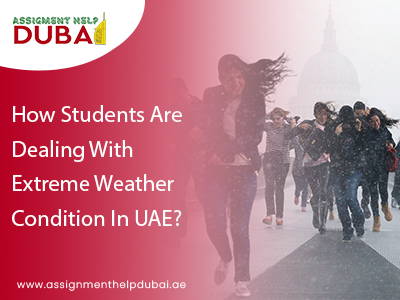The Climate Challenge:
Generally, a desert region, the UAE traditionally hosts high temperatures, especially during the summer months when the mercury climbs above 45 degrees Celsius. However, extreme weather conditions in recent years have spiraled.
The summer of 2024 has been recorded as one of the hottest ever, and unprecedented heavy rains have created flooding in areas not used to that condition. Such extreme weather disrupts daily life and has a tremendous impact on the educational environment for students.
Impact On Student Life & Health:
Health risks such as dehydration, heat exhaustion, and, in extreme cases, heatstroke are associated with high temperatures, and this could be a grave danger to students. To this end, most learning institutions in the UAE have gone to great lengths regarding safety.
The majority of schools and universities in the country have air conditioning within the premises, to the extent that an indoor learning environment is controlled and safe. Outdoor activity is usually scheduled for the coolest part of the day, and on days that may be excessively hot, the activity would be either canceled or taken indoors.
The other end of these challenges is the rain and flooding, which happen unwarranted. The schools will have to be ready for a short-notice closure and should have a good infrastructure that can hold up against the rain to prevent hazards, which include water damage and the possible mold growth in classes, which can impact the quality of air and lead to breathing issues in students.
Technological & Structural Adaptations:
Learning institutions have also adapted to the use of technology and improvements in infrastructure to fight and manage such extremes. Most schools have adopted modern weather monitoring systems that allow for the real-time updating of the weather situation.
This helps a great deal with good preparedness and making decisions on time when talking about matters dealing with the running of schools in case the weather goes south.
The structure will be designed or retrofitted to endure intense weather, with features such as improved insulation against heat and better drainage systems against flooding from a heavy downpour.
Greening roofs and the provision of shaded areas not only save heat but also offer a welcomed outside location for students to spend their break time.
Educational Continuity Through Digital Means:
One of the most significant adaptations to severe weather involves the shift toward digital platforms for education. The recent COVID-19 pandemic made this more prominent. It proved to be quite a game-changer in the educational continuity map during severe weather disruptions.
Schools and universities in the UAE have very effective digital infrastructure in place that would allow them to switch to online learning if students cannot come to study on campus. This flexibility ensures that learning does not stop, regardless of the weather outside.
Awareness & Preparedness Programs:
In controlling the same, one of the most important aspects is extreme weather awareness, and institutions of learning fit centrally into this role. Schools hold regular sessions and workshops on handling extreme weather conditions; they teach the significance of hydration, how to recognize early symptoms of illnesses stemming from the heat, and what one ought to do if there is flooding.
All these kinds of programs aim to empower students with knowledge. It puts them in a position to safeguard themselves and their peers during bad weather.
Mental Health Considerations:
Also, extreme weather can increase the levels of stress and anxiety in students. Schools in the UAE are now starting to appreciate the importance of mental health and are incorporating support systems that will help students cope with the stresses occasioned by harsh weather conditions.
Such services include counseling, mindfulness programs, and stress management workshops. They are growing in prevalence to empower students with tools that will keep their mental equilibrium in the face of environmental challenges.
Enhanced Emergency Response Training:
The unpredictable nature of an extreme weather condition calls for schools to enhance their emergency response preparedness. Drills and training for all the students and the staff should be periodic to enable the latter to know the right procedures in times of emergency weather disturbances characterized by sudden, severe changes, for instance, a severe sandstorm and flooding. This involves evacuation procedures, first aid provision, and emergency supply use.
Collaboration With Meteorological Experts:
Weather education and weather-related courses offered by Assignment Writing Services are slowly becoming part of the general educational system, with many institutions liaising with and forming collaborations with meteorological experts.
This includes courses related to climate change, understanding of weather conditions, and studying the mechanisms of weather prediction. Such knowledge is vital for building a generation that is not only aware of but also capable of responding to and advocating for solutions to climate-related challenges.
Enhancing Indoor Air Quality:
Extreme weather events, such as sandstorms or flooding, further degrade indoor air quality, with these environments in turn putting large amounts of particulates and allergens in the air. Schools invest in advanced air filtration systems to ensure the indoor environment is healthy and conducive to learning, irrespective of the outdoor conditions.
Community Resilience Programs:
In many cases, schools are the outpost of the community; in the event of extreme weather, the schools remain the final link in community resilience and response support, often working in collaboration with local authorities, churches, and other institutions, particularly NGOs. Schools may serve as shelters, information centers, and aid distribution points, all helping to build up general community capacity to resist the negative impacts of the weather.
Conclusion:
UAE students are already the forebears of these climate changes and their implications in real life and education. These students learn to effectively tackle the challenges at hand because of the various improvements in technology and infrastructure, comprehensive educational courses, community support, and governmental investments.
The lessons learned and the strategies implemented in the UAE can serve as a model for other regions facing similar climatic challenges, highlighting the importance of preparedness and adaptation in the face of increasing weather extremes.

